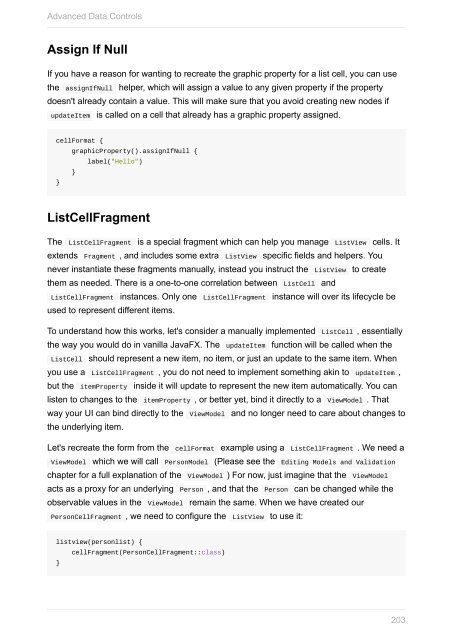tornadofx-guide
Create successful ePaper yourself
Turn your PDF publications into a flip-book with our unique Google optimized e-Paper software.
Advanced Data Controls<br />
Assign If Null<br />
If you have a reason for wanting to recreate the graphic property for a list cell, you can use<br />
the assignIfNull helper, which will assign a value to any given property if the property<br />
doesn't already contain a value. This will make sure that you avoid creating new nodes if<br />
updateItem is called on a cell that already has a graphic property assigned.<br />
cellFormat {<br />
graphicProperty().assignIfNull {<br />
label("Hello")<br />
}<br />
}<br />
ListCellFragment<br />
The ListCellFragment is a special fragment which can help you manage ListView cells. It<br />
extends Fragment , and includes some extra ListView specific fields and helpers. You<br />
never instantiate these fragments manually, instead you instruct the ListView to create<br />
them as needed. There is a one-to-one correlation between ListCell and<br />
ListCellFragment instances. Only one ListCellFragment instance will over its lifecycle be<br />
used to represent different items.<br />
To understand how this works, let's consider a manually implemented ListCell , essentially<br />
the way you would do in vanilla JavaFX. The updateItem function will be called when the<br />
ListCell should represent a new item, no item, or just an update to the same item. When<br />
you use a ListCellFragment , you do not need to implement something akin to updateItem ,<br />
but the itemProperty inside it will update to represent the new item automatically. You can<br />
listen to changes to the itemProperty , or better yet, bind it directly to a ViewModel . That<br />
way your UI can bind directly to the ViewModel and no longer need to care about changes to<br />
the underlying item.<br />
Let's recreate the form from the cellFormat example using a ListCellFragment . We need a<br />
ViewModel which we will call PersonModel (Please see the Editing Models and Validation<br />
chapter for a full explanation of the ViewModel ) For now, just imagine that the ViewModel<br />
acts as a proxy for an underlying Person , and that the Person can be changed while the<br />
observable values in the ViewModel remain the same. When we have created our<br />
PersonCellFragment , we need to configure the ListView to use it:<br />
listview(personlist) {<br />
}<br />
cellFragment(PersonCellFragment::class)<br />
203




